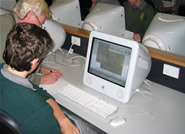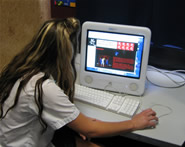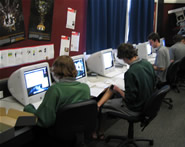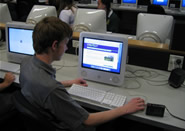
Case Study BP809: Year 11 Web Design Unit
Abstract

Reference: BP809
Classroom Practice: Year 11
Title: Year 11 Web Design Unit
Duration: One year
Overview:
Students were asked to develop a web-based solution for a specified issue, using combinations of text, images, audio, and animation, paying particular attention to the link between content and design. The unit was designed to further embed recent improvements to teaching and assessment within the school's Technology Faculty – see case study BP 604: Teaching Technology in an ICT Context. Key aims of the unit were to increase the depth of ICT knowledge and skills in parallel with an increase in the complexity of Technological Practice and to reinforce the link between Technological Practice and ICT knowledge and skills. Outcomes achieved include improved teacher-student interaction and a streamlined assessment process.
Background
Katikati College in the Bay of Plenty is a decile 6 co-educational Year 7-13 school with a role of about 950 students. In Years 7-9, students follow a broad Technology programme in Materials, Food, and Information and Communication (ICT) Technology. At Year 10 students must choose a full-year option from ICT, Food, Hard and Soft Materials, or Graphics. The ICT option leads into a Year 11 ICT programme in which the full year's work is built around a web solution. At Year 12, the ICT option again sits alongside other technology options, as well as unit standards courses in Computing, Furniture Making, and Hospitality. The Technology Faculty at Katikati is headed by Malcolm Howard. Malcolm designed the course with teacher Steve Graham, who is now teaching at Tauranga Boys' College.
Steve and Malcolm participated in the Katikati College and Hillcrest High School Beacon Practice cluster, which involved an extensive campaign to improve the teaching and assessment of technology in an ICT context – see case study BP 604: Teaching Technology in an ICT Context and other related case studies. One of the first classes to benefit from this initiative was the 2006 Year 10 ICT class (see case study BP 628 A Junior ICT Programme). That 2006 Year 10 ICT class was highly motivated and the outcomes they had achieved were very satisfactory, and had enjoyed the experience so much that most had opted into the Year 11 ICT/Technology class.
Pre-planning

When planning the Year 11 course, Steve knew he had highly motivated, high-achieving students, and it was therefore vital to maintain their enthusiasm and learning momentum. The course was planned to deepen the breadth of knowledge students had gained in the four Year 10 units and prepare them for ICT courses at Level 2 and Level 3, and at the same time achieve a balance between learning technological practice and ICT domain knowledge and skills.
Specifically, Steve wanted the students to move beyond web-authoring software, such as Dreamweaver , which has a 'what-you-see-is-what-you-get' (wysiwyg) interface, and write some code themselves into a text editor using XHTML and Cascading Style Sheets (CSS) ; and experiment with Flash and ActionScript . Rather than focus on one of the components of practice each term as they had done the previous year, students would be required to integrate the three components into a single, large project.
The Year 11 course was designed to dovetail into a planned Year 10-Year 13 learning progression, Malcolm says. "Year 10 is like the sampler if you like – lots of skills but nothing in too much depth. Year 11 is much deeper, but it's still a teacher-directed project – students are all doing something related to the web. They are all learning the same set of skills to start with, and they don't have a choice on the issue. The issue is described, and students simply choose a context for that issue. Year 12 is far more open in terms of how they choose their issue and what sort of outcome they produce. And at Year 13 students select a client and identify a suitable client issue and from that they choose their own set of skills, which could be quite different from their classmate's."
The Year 11 course would cover: website creation, computer graphics, animation and programming, presentation and design skills, and the social issues related to ICT. Steve spent a lot time before the start of the 2007 school year developing resources, including handouts and a series of worksheets; he estimates about two-thirds of the resource material was printed out as hardcopy. He also used some of the Natcoll publications, including Natcoll Flash and Natcoll ActionScript.
Steve arranged a software developer from Tauranga software company Cucumber Software to visit the class. Before the visit, Steve sent the guest speaker a brief (.pdf, 54Kb), outlining where the students were at and suggesting some areas that could be covered in the presentation.
Delivery

Four one-hour periods were available each week to deliver the course. The course was practically-based with one major web-related project. The major unit had a number of parts and involved a wide range of skills:
By way of a context for the unit, students were asked to develop a web-based solution for a business, an organisation or a club that communicated appropriately to its target audience. The solution need not be a website – it could, for example, be a Flash movie for an existing website. In Year 10 the class had created a web page using the web-authoring software Dreamweaver ; in the Year 11 unit they would learn the actual coding of web pages, including using CSS and XHTML . Students were introduced to computer programming using the ActionScript programming language and web animation using Flash . Steve introduced the Nature of Technology strand by having students critically examine the web and the way people use it to communicate.Term 1 began with five weeks of skill development. Students created a simple website using XHTML and CSS.
Topics covered included:
Initially three weeks were allowed for this, but in fact it took five weeks.
In week four of the first term, students received their major web project. Students were required to decide on their own specific context for their work.
The remainder of the term was spent learning how to create animations for the web using Flash and how to place these animations on a web page using a text editor; learning how to design web pages following good design principles; and learning how to manipulate and optimise images in Photoshop for use on web pages. Students were reminded about the principles of typography and design they had covered the previous year. Steve had the students use visual diaries to capture their ideas.
Term two began with a shift in focus back to Technological Practice. Students revised and extended their Year 10 understandings, then went on to spend most of the term developing briefs for their projects. They researched their chosen issue and their stakeholders. They identified key factors; researched needs and opportunities; and researched for ideas. Project concepts were developed and refined in consultation with stakeholders. Initial briefs were written and, after research into the ethics and codes of practice followed by professional web designers and the pertinent legal considerations, refined. Some initial assessment of brief development occurred at the end of term 2 checkpoint. Steve conferred with the students one-on-one at this stage to check progress and provide students with formative feedback.
Term 3 started with a small (2-3 week) unit on how to use the programming language (ActionScript) to produce interactive animations for web pages. This upskilling hadn't originally been planned for but it was felt it was needed to break up the project work. The remainder of the term and two weeks of term 4 were spent developing and evaluating outcomes. Students planned their workloads and further developed their ideas with stakeholders into complete working websites. The last four weeks of the fourth term were spent resubmitting for internals and preparing externals for assessment.
Assessment

Rather than taking an 'either/or' approach, Steve used a mixture of technology achievement standards and ICT unit standards for assessment. The course was assessed using Level 1 achievement standards and one Level 2 unit standard:
A total 28 credits were achievable; however, most students submitted for 20 -24 credits.
For each standard there was one formal assessment and one further resubmission opportunity. The key evidence for the externals was submitted as a written report/portfolio (either on a CD or on paper or as a combination of the two) along with a visual diary. Students were required to sign an authenticity sheet for all assessments to verify the work was their own.
The unit embraced the alternative ways identified by the Beacon cluster to gather and present assessment evidence using the technology available in an IT classroom. Alternative Assessment Schedules had been developed and since updated. Also, instead of using folios exclusively to document their work, students were encouraged to use methods such as screen shots, digital photos, audio clips and digital videos.
The aim of using the Alternative Assessment Schedules was to help students better understand the assessment criteria and what assessment evidence they should be gathering. By so doing it was hoped student practice would be project-driven rather than assessment-driven. In the best-possible case, the assessment requirements would naturally 'fall out' of the process.
At each of several one-on-one teacher/student conferences, students were questioned about their practice and development of their outcome; the aim was to have students understand exactly what was required of them and have them gather enough of the right kind of assessment information.
Students provided with checklists to ensure they covered all the assessment bases. This approach worked well, says Steve. The students also received formal 'checkpoints' through the year at which they had to submit work for assessment.
Outcomes



Cerise's website Ethan's website Matthew's website



Monica's website Paul's website Sven's website
Click any image to visit the website
The unit was highly successful in a number of ways:
Students rose to the challenge of selecting a project in which they could "pretty much do anything" while not losing sight of the original goal. The outcomes were diverse, individual, and of high quality. Interestingly, while the outcomes were very different in content, they were similar in design. This may reflect, at least in part, the emphasis placed on Codes of Practice and current accepted standards by both the teacher and the visiting software expert.
While some students found programming easier than others, the programming work provided students with a good introduction to the level of programming required in the Year 12 and Year 13 courses. Overall, the unit's theme worked well in providing scope for a good range of skills and ICT domain knowledge to be developed. Students enjoyed the variety of skill development work.
Students enjoyed the increased level of technical control they could exercise over their web projects. One student noted: "This year we've learned about the areas behind the website as such; whereas before we were just using visual (wysiwyg) programs to make a website, now we can actually use the code."
Students commented that their Year 10 work had been good preparation for the Year 11 course. One student mentioned that the technological practice – brief development, planning for practice etc – he learnt in Year 10 had stood him in good steed during his Year 11 course. He also suggested the students who hadn't done Technology previously may have found it more difficult to allocate their time and complete tasks to deadline.
Another student, who hadn't previously done ICT, found the understanding she gained in Year 10 Food Technology helped with her Year 11 ICT work, reflecting the value of a good grounding in generic technological practice.
Students enjoyed the opportunity to be creative when documenting their practice. As part of their Beacon Practice work, Steve and Malcolm worked with Beacon Practice Professional Support Facilitator Hugh Derham to find ways of creating opportunities for creativity in Technological Practice. One of his suggestions was the use of visual diaries in which students could record ideas in an easy, informal way. This, he reasoned, would not only stimulate creativity but also serve as an alternative means of recording evidence of achievement for assessment.
Steve said the approach was successful but seemed to work better with girls than boys.
Having an outside expert visit the classroom was highly informative with the visitor covering all the material he had been asked to, and the students were attentive. However, Steve felt that students missed the opportunity to swamp the visitor with questions afterwards.
The unit encouraged students to be creative and to have fun. Presenting students with plenty of variety and opportunities for creativity resulted in increased student engagement, and was reflected in the increased number who elected to continue with the subject in Year 12.
Steve believes the alternative assessment schedules have been an "absolutely critical factor" in determining the quality of the outcomes achieved and has given the students a better understanding of what they are doing and why they are doing it. "Basically, using the schedules has given consistency for me and clarity for the students. I wouldn't want to go back to what we had."
What next?
Malcolm is teaching the Year 11 course in 2008 with several refinements.
"...it's just ongoing incremental improvement. We've added a skills module on Javascript. We now use the Natcoll manuals rather than our own worksheets. We don't use AS 1.7. And we're introducing the project a lot earlier; we don't do only skills in term one any more. I've done some skills in term one then started them on their project. I'll bring in some more skills in term two."
Malcolm is also using the revised alternative schedules for the version 3 and 4 achievement standards.
"These will provide greater opportunity for ongoing teacher-student interaction, streamlining and simplifying the assessment process."
Malcolm: "Once we move out of the skill development phase and into the early stages of the project we want to have this ongoing interaction, to actually record evidence from our discussions with students on the schedule."
Even before the Year 11 unit was first designed and delivered, the ICT department had been moving from providing paper-based resources for students to intranet-based delivery. This process is ongoing. The department is also moving to 'bite size' resources rather than trying to cover too much in any one resource. For example, a planning resource covering milestones and key stages is now accompanied by other resources focussing on different aspects of planning. These small resources are posted on the school intranet in a variety of formats.